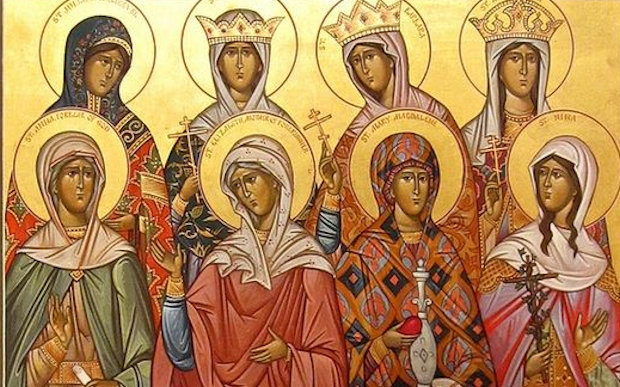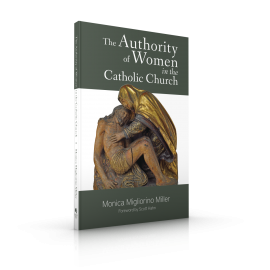By Monica Migliorino Miller
Dr. Monica Migliorino Miller is a professor at Madonna College. She has written extensively on the subject of women in the Church, including in her book The Authority of Women in the Catholic Church.

The Church Fathers (those great bishops and theologians of the first five hundred years of Christianity) are a special target of feminist rage, and it must be admitted that these early Church thinkers are certainly not well known for their support for women’s liberation. It must be acknowledged that most of the Church Fathers were heavily influenced by Neoplatonism, a radically dualist philosophy that associates men with good and women with evil. Men represent spiritual realities, God, the soul, the intellect—realities that are permanent and unchanging, thus good. Evil is all that has fallen away from the spiritual realm, namely, the earth and material existence. Women, by their nature, are on the side of this fallen realm. There can never be an inherent peace between the two realms. If anything, they are inherently antagonistic. In a perfect world all human beings would be male. Better yet, there would be no sex at all. The fact of sexual difference is the first and most primary indication that something is wrong with the world. In Platonic thought, a world filled with difference is fragmented. It is a world that has ceased to have unity because it is fallen from the One, the monist realm of spiritual unity in which the fragmentation of temporal existence is swallowed, including sexual differentiation.
Order in such a disunified and antagonistic world is achieved through domination and suppression by the superior male force over the inferior female force. The elimination of chaos is accomplished by the rational male’s control over the irrational female. And so this totally false and unnecessary battle of the sexes continues even to the present day.
The Fathers of the Church lived in a time dominated by a pagan philosophy whose degrading view of women was confronted by the faith of the Church which, according to its sacramental and moral life, teaches that men and women share an equal dignity and are partners in redemption. In the writings of the Fathers, Greek philosophy is not obscuring Christian revelation; rather, it is the Church’s revolutionary teaching that is slowly and painfully displacing the dominant philosophical view that women are inferior to men. When the Fathers base their writings on the revelation of Christ, a view of women begins to emerge that recognizes their essential role in the fulfillment of the world’s redemption in Christ. This redemption is dependent upon women, a dependency that is rooted in the created goodness of women as such.
St. Augustine taught that the salvation of the world was historically accomplished by a covenant between Christ and Mary. Indeed, Augustine defends the honor of Mary against the heretics of his day who deny the goodness of the body and the female sex. The Gnostics denied that God in Christ could or would have anything to do with a woman, much less be conceived and given birth to by one! Such a thing was utterly scandalous to them, but not so for Augustine:
Those likewise are to be detested who deny that our Lord Jesus Christ had Mary as his mother on earth. That dispensation did honor to both sexes male and female, and showed that both had a part in God’s care; not only that which he assumed, but that also through which he assumed it, being a man born of a woman.
There is no indication that one sex is superior to the other. The fact that God entered human history as a male does not mean the male sex is superior. St. Augustine clearly teaches that through the Incarnation God honors both sexes. Moreover, both sexes are actively involved in the world’s redemption. It is important to note that St. Augustine is not afraid to affirm that Christ is dependent on Mary.
For St. Augustine, the Church is the New Eve. His teaching affirms that femininity is part of the order of redemption. Augustine’s exegesis on Psalm 127 states that salvation is centered on a pair: Christ and His Church. This is a nuptial pair, as Christ and His Church are prefigured in the first couple. Augustine specifically affirms this in the beautiful way he parallels the divinely induced sleep of Adam with the sleep of death Christ experienced on the Cross, from whose pierced side came the Church, the New Eve.
As regards the authority of women, it is important to note that Christ is not effecting salvation alone. Salvation is effected through the Church, His Bride, who exemplifies all that is feminine. In Augustine’s theology there is a sense in which the feminine Church is a co-cause of salvation. The Church, for instance, gives birth to Christ’s children. Eve, who bore children in suffering, is the sign of the Church who will bear children spiritually. The Church bears children specifically as Christ’s Bride. As a mother she suffers over her children, groaning over them. In this way, the Church is the true “Mother of all the living” who looks forward to the time when her children shall rise from the dead and all “pain and groaning shall pass away.”
St. Augustine does not disparage what is feminine. Indeed, salvation is accomplished through the feminine. His theology at least implies that an equal dignity exists between the male Christ and the female Church. This is, of course, the “whole Christ,” the Christus totus, the Head and the Body, sponsus and sponsa.
You Might Also Like

Examining one of the most divisive issues today, The Authority of Women in the Catholic Church details the role of women in the covenant of salvation. Dr. Monica Migliorino Miller defines authentic feminine authority with the support of Scripture, the writings of the Church Fathers, contemporary theological insights, and historical witnesses to the role of women in the Catholic Church.